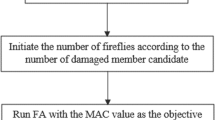Abstract
Too many sensors and data information in structural health monitoring system raise the problem of how to realize multi-sensor information fusion. An experiment on a three-story frame structure was conducted to obtain vibration test data in 36 damage cases. A coupling neural network (NN) based on multi-sensor information fusion is proposed to achieve identification of damage occurrence, damage localization and damage quantification, respectively. First, wavelet packet transform (WPT) is used to extract features of vibration test data from structure with different damage extent. Then, data fusion is conducted by assembling feature vectors of different type sensors. Finally, three sets of coupling NN are constructed to implement decision fusion and damage identification. The results of experimental study proved the validity and feasibility of the proposed methodology.
Similar content being viewed by others
References
Doebling, S.W., Farrar, C.R., Prime, M.B., 1998. A summary review of vibration-based damage identification methods.The Shock and Vibration Digest,30(2):91–105.
Gao, Y., Spencer, Jr.B.F., 2002. Damage localization under ambient vibration using changes in flexibility.Journal of Earthquake Engineering and Earthquake Vibration,1(1):136–144.
Guo, J., 2004. Study of Structural Damage Identification Based on Wavelet Analysis. Ph.D. Thesis, Zhejiang University, Hangzhou, China (in Chinese).
Guo, J., Sun, B.N., 2005. Multi-scale analysis based on wavelet transform in bridge health monitoring.Journal of Zhejiang University (Engineering Science),39(1): 114–119 (in Chinese).
Ni, Y.Q., Wang, B.S., Ko, J.M., 2002. Constructing input vectors to neural networks for structural damage identification.Smart Materials and Structures,11(6): 825–833.
Qu, W.L., Chen, W., Li, Q.S., 2003. Two-step approach for joints damage diagnosis of framed structures by artificial neural networks.China Civil Engineering Journal,36(50):37–45 (in Chinese).
Sun, Z., Chang, C.C., 2002. Structural damage assessment based on wavelet packet transform.Journal of Structural Engineering,128(10):1354–1361.
Teng, J., Liu, H.J., Qu, W.L., 2004. Error Compensation Technique for the Structural Health Monitoring Sensor Systems. Proceedings of the Eight International Symposium on Structural Engineering for Young Exports. Science Press, Xi’an, China, p. 345–365.
Yen, G.G., Lin, K.C., 2000. Wavelet packet feature extraction for vibration monitoring.IEEE Transaction on Industrial Electronics,47(3):650–667.
Wang, M.L., Heo, G., Satpathi, D., 1998. A health monitoring system for large structural systems.Smart Materials & Structures,7(5):606–616.
Author information
Authors and Affiliations
Corresponding author
Rights and permissions
About this article
Cite this article
Jian, G., Yong, C. & Bing-nan, S. Experimental study of structural damage identification based on WPT and coupling NN. J Zheijang Univ Sci A 6, 663–669 (2005). https://doi.org/10.1631/jzus.2005.A0663
Received:
Accepted:
Published:
Issue Date:
DOI: https://doi.org/10.1631/jzus.2005.A0663




